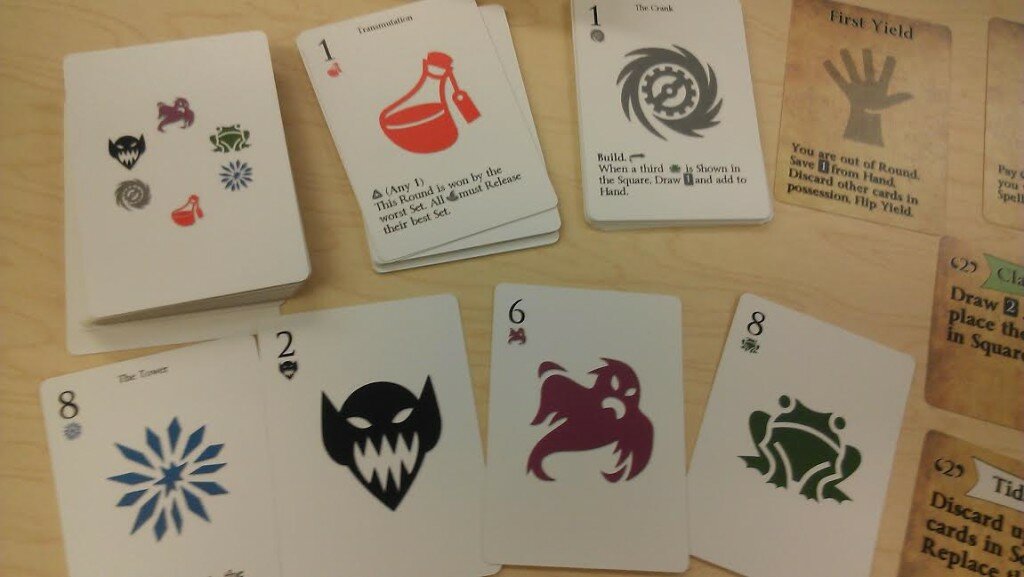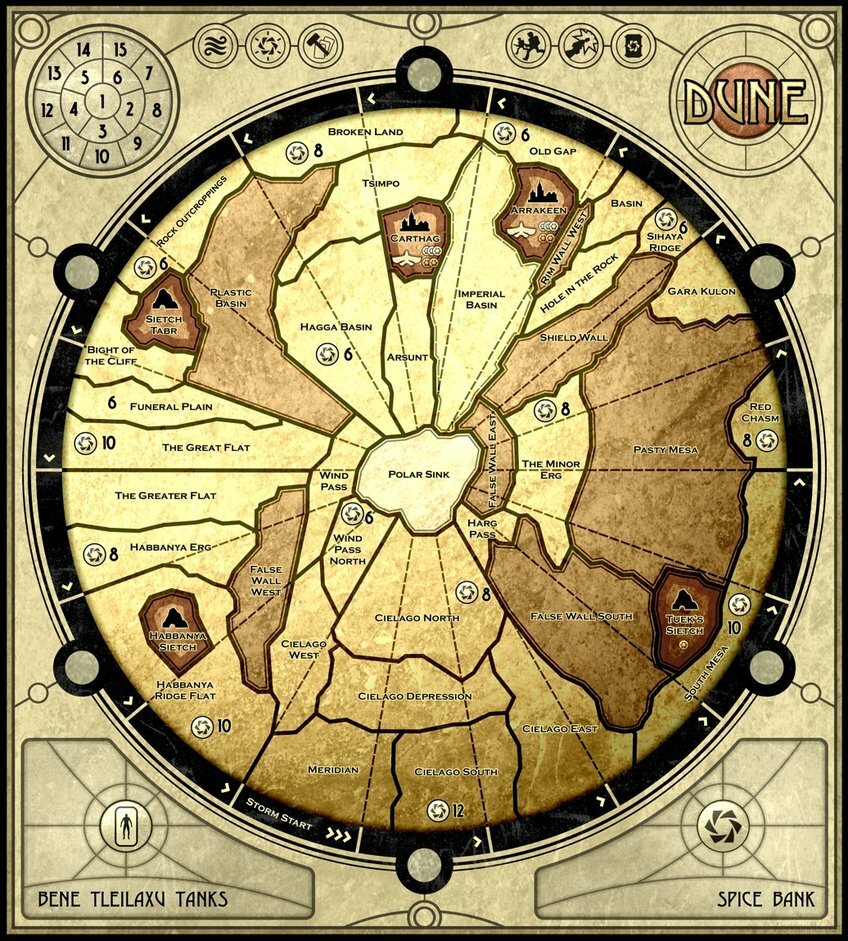Post by: Joshua Buergel and Grant Rodiek
Grant: When you reach a design iteration you dub “5.0” it may be time for what my mom refers to as the “come to Jesus meeting.” We’ve been scrambling for months to find a new framework for Hocus Poker. At the top of the Summer we threw away something that worked and had been received well because we didn’t think it was good enough. But, we’ve spent a lot of time since then trying to do it better.
Last week we tested Hocus Poker 5.0 and to be completely honest, had it not gone well, I think I might have walked away.
Josh: I’d have tried to talk you off the ledge, but it would have been time to question some fundamental assumptions. For instance, I’m not sure we could have continued on the path of having no separate betting tokens. It’s something we were keenly interested in getting right, for a number of reasons we’ve talked about before, but our iterations in this area have been unsatisfying.
Grant: To quickly reiterate, we wanted to craft a game that was cards only to save on production costs, portability, and keep the MSRP low. We were sticking to our guns of no player elimination in a game that is built on it. You know, poker.
Josh: But that was down the road. We had time to go for another major revision and see if we didn’t have another shot in us. But where to start? Grant had a playtest that didn’t go well, so that was our starting point. The 4.0 build wasn’t terrible, exactly, but it was unexciting. There were some promising bits to it, as usual, but it just didn’t leave the players excited.
This version had dual use cards (with points on the cards), some special cards in the regular deck, and attempted to feature a short decision cycle with small hands being built up gradually and a series of small showdowns.
Grant: One positive note was that my testers said it was much better than previous versions, but that was a low bar. Still, progress.
Josh: It was becoming clear that the showdowns were a problem, to me. They should have been exciting, fun, and surprises should have happened regularly. What was happening, instead, was really rote. The idea of having them happen as things went along just wasn’t quite working the way we wanted. A good idea, maybe, but not for this game.
Grant: More fundamentally, we had a lack of good decisions. You could see this in the Showdowns, building Hands, and betting. Sound probability indicated a very boring strategy: pick the best pair possible. This would often become a 3 of a kind or Full House once the Community was revealed.
We wanted players to have fun decisions throughout. That seems obvious for any game, but it’s really not. Or more accurately, how to execute against that is not. In Texas Hold ‘Em, you don’t get to change your cards. It’s all about bet management, which is done to bluff, bully, or accurately represent your hand.
In Hocus we let players change their cards and reduced the importance of bet management. However, with such simple cards, it was basically just a matter of cycling to create the most sure thing you could. It was dissatisfying.
Josh: Full Houses have been a recurring problem for us. Honestly, we should be smart enough by now to recognize that if they’re popping up too much, we’ve somehow goofed.
Grant: Players felt like they were stuck on a ride. Get in, build a pair, see what happens.
Josh: I don’t think we’re aiming for a really agonizing game here, but there needs to be a skill component to things, obviously. It should be a lightweight strategy game, not an “experience”.
Grant: Yeah. Honestly, we were making the “It’s a Small World” of fillers, which I don’t think is a good thing.
Josh: To be clear, that’s a Disney reference, people.
Grant: Let it go.
Josh: BOOO.
At any rate, something had to give. We needed a way for people to have some planning in the game. It just needed to happen. Grant and I both had an idea kicking around in our heads, which was simple: why not give people a bunch of cards at the beginning of the round? They could then work on allocating things themselves.
Grant: Things being their hands, the community, or the pot. Collaboratively and competitively.
Josh: On top of that, we could retain the simultaneous hands by putting two communities in play. Now, we got to keep the idea of building multiple hands, which we liked from the previous version, while keeping some form of planning. Once those planks were in place, the 5.0 version came together quickly.
Grant: That’s a super key point I don’t want to gloss over. Previously, we let you build 2 hands under the guise of strategy. One for now, one for later. That didn’t pan out, but it WAS fun building multiple hands. Naturally, we needed a second place to use that second hand.
If 2-4 players are building a Community at the same time, there’s a little bit of volatility. By building 2 Hands, you increase your chances of capitalizing on one. Two, if you’re lucky or good.
Josh: I was briefly advocating for three simultaneous hands, honestly. Maybe for an expansion?
Grant: I think it might be viable as a wink wink 2 player version.
Josh: Honestly, the biggest problem in this version has been what to name things. “Hand” is overloaded, and people didn’t like “Holding” for what they wanted to call their “Hand.” So, we’ve had to juggle stuff around on names.
So, we worked this out, and Grant had a playtest. And, I would describe it as “triumphant.” He wrote to me, and his email was full of jubilant swearing, which is the best kind of swearing.
Grant: I was throwing hip hop hands in the air. For the record, I did not care.
Josh: Not quite ready to believe it, I ran a test myself last night with three of my friends, grizzled veterans of the Hocus Poker development process. These fine, determined gentlemen have played every major version of this thing, going back to the version with little tiles.
And, one of them said that “it’s the most fun he’s had with any version of Hocus Poker,” and another described it as “very polished.”
There’s clearly balancing work to do on spells, but after the first round, I was just playing the game. I was taking notes, sure, and noticing wording and things to tighten up. But I was just playing the game. It’s been the first time since some of the late 2.0 versions when I’ve had actual fun playing it. That sounds bleak, but we learned stuff from every one of those unfun games which I think we’ve applied. It actually seems good now!
So, where to go from here? What lessons can we learn? Persistence always pays off?
Grant: We have a lot of work left in spell balance, tuning, and proper wording. But, that’s a relatively easy part compared to where we’ve been.
As for high level, a big thing for me is that we kept slamming on the brakes. We threatened to stop the car and we actually stopped the damn car. It was really difficult to do again and again, but it really paid off. You have to hold yourself to a quality bar. There are just too many other good games to make something mediocre.
I also think we learned a great deal about identifying what we want to do with the game and how to get there. We never flailed. It felt like flailing. But, we went about it in a rather constructive and thoughtful way. We stopped repeating bad spells. We avoided known bad ideas that never seemed to work. Yes, we’ve tried Banished 30 times, but we all have to have a windmill or two at which to tilt.
Dude, so many sweet references.
Josh: At least we amuse ourselves.
I think we can identify something useful that came out of each major revision that has still stood up. 3.0 gave us the idea for individual spellbooks.
Grant: This was a huge breakthrough. Instead of all sorts of mixed actions, the spellbooks said: execute one of the four cards in front of you. Plus, your four cards are unique. Great for accessibility.
Josh: 4.0 gave us the gems on the creature cards. Those are integral parts of the game, which are solid ideas that are making things better.
Grant: I love multi-use cards. They are just so much fun. It also works really well for our poker setup. Do you use a card for its suit, strength, or Gem? 3 uses is very simple and easy to process. It provides a nice layer of choice. Looking beyond that, you think about building a pair, a straight, and how to best set yourself up for a bigger hand via the community.
Josh: Those revisions were not in vain, they just, you know, weren’t any fun. A careful post mortem of each playtest helped show which are the parts that were working, and we’ve been able to carry those forward. The ideas in 5.0 are ones that we’ve painstakingly chipped away from all the other ideas that have been floating around.
Maybe that’s a new benchmark for me? Try and salvage one really solid idea from every playtest, no matter how badly things went.
Grant: It’s a good goal and a very achievable one. I can finally talk about this — I learned a great deal working with Portal on York/Dawn Sector. They had no qualms saying “not good enough,” and I wanted to be good enough to emulate that in my own craft. But, man. It can be crushing sometimes.
I think, and this is bold, we should share the rules. You can read them here. They are about 1400 words from start to finish, which we’re really proud of.
Josh: It’s hard saying your own efforts aren’t good enough. This part was kicked off by deciding that a game that people had played and enjoyed didn’t make the mark. That’s rough enough, but continually kicking a bunch of revisions down because they weren’t fun was dreary, but it’s been worth it.

